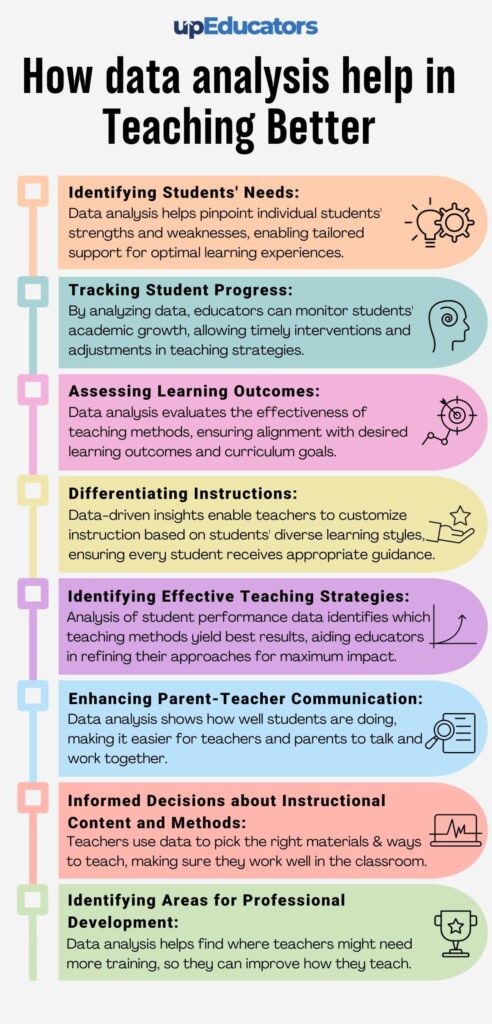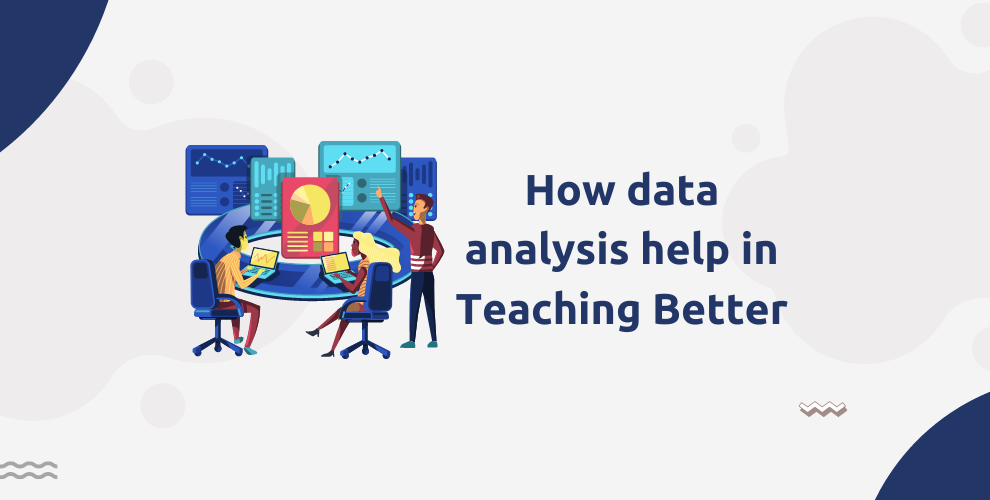Ms Aditi, an enthusiastic educator, recognized the potential of data in her classroom. Using assessments and surveys, she delved into the data to gain valuable insights for improving her teaching methods. Diligently examining student performance, she pinpointed areas where they needed more support and identified individual requirements. Utilizing this information, she crafted customized lessons that catered to each student’s needs, incorporating engaging activities.
Witnessing the wonders of personalized learning, the students enthusiastically embraced Ms Aditi’s data-driven approach. Their motivation surged, and day by day, their progress soared. Through her unwavering commitment and strategic utilization of data, Ms Aditi transformed her classroom into a dynamic centre of knowledge, igniting her students’ thirst for learning.

Working with data analysis limits guesswork and helps teachers rely on facts and figures. data analysis in teaching are packed with multiple benefits if used precisely.
After training 10,000+ Teachers in learning digital skills and 21st-century teaching skills, the expert trainers at upEducators have found the best data analysis practices for teachers and their benefits. In this blog, we throw some light on the benefits of using data analysis in teaching. So let’s dive in straight and look at some of the benefits.
Identifying Student Needs
Utilizing data analysis in teaching provides valuable insights into students’ needs and requirements. By examining various data points such as assessments, quizzes, and classroom observations, teachers can gain a comprehensive understanding of each student’s strengths, weaknesses, and learning styles. This information enables educators to identify knowledge gaps and areas where students may be struggling. With this knowledge, teachers can tailor their instructional strategies and lesson plans to address individual needs effectively.
Tracking student progress
By collecting and analyzing various forms of data, such as assessments, quizzes, and assignments, teachers can monitor individual student performance over time. This allows educators to identify trends, patterns, and areas of improvement or concern. With this information at hand, teachers can provide timely and targeted interventions to support struggling students and challenge those who are excelling. data analysis provide a clear picture of each student’s growth and development, enabling teachers to make informed instructional decisions and adjustments to optimize learning outcomes.
Assessing Learning Outcomes
By comparing the data against predetermined benchmarks or standards, teachers can determine the effectiveness of their instructional strategies and adjust their teaching methods accordingly. data analysis help teachers make evidence-based decisions about curriculum design, instructional techniques, and interventions to improve learning outcomes for their students. It provides a clear and objective measure of the impact of teaching efforts and helps in driving continuous improvement in the classroom.
Differentiating Instructions
Data-driven differentiation enables teachers to provide personalized learning experiences that foster student engagement, motivation, and academic growth. It ensures that students receive the necessary support and opportunities to succeed, regardless of their individual abilities or prior knowledge.
Identifying effective teaching strategies
Through data analysis, teachers can determine which teaching strategies and approaches are most effective in promoting student learning and achievement. They can identify patterns and trends in the data that highlight successful instructional techniques or areas that may need improvement.
Furthermore, data analysis help teachers to assess the effectiveness of specific tools, resources, or technologies used in the classroom. They can determine whether certain interventions or instructional materials have a positive impact on student learning outcomes.
Enhancing Parent-Teacher Communication
By utilizing data, teachers can provide evidence-based insights to parents about their child’s academic progress, strengths, and areas for improvement.
Sharing data-driven information allows teachers to have meaningful discussions with parents, enabling them to provide a comprehensive understanding of the student’s performance. This data can include assessment results, classwork samples, and observations that support the teacher’s assessment of the child’s progress.
Additionally, data analysis can highlight patterns or trends that may require additional attention or intervention. Teachers can use this information to initiate discussions with parents and collaboratively develop strategies to support the student’s learning and development.
Furthermore, data provides a basis for productive conversations regarding goal setting and progress monitoring. Teachers can use data to illustrate how a student is progressing towards specific learning objectives and engage parents in the goal-setting process.
Making informed decisions about instructional content and methods
By collecting and analyzing student data, teachers gain valuable insights into individual strengths, weaknesses, and progress. This information guides the selection of appropriate instructional materials, pacing, and differentiation strategies to meet diverse student needs. Analyzing data also helps identify common misconceptions or gaps in understanding, enabling targeted interventions. Furthermore, it allows teachers to assess the effectiveness of their instructional strategies and make data-driven adjustments.
Identifying areas of professional development for teachers using data
By collecting and analyzing data related to student performance, classroom observations, and feedback, teachers can gain insights into their instructional practices and areas for growth. These data-driven insights can be used to identify specific areas where teachers may benefit from additional training, resources, or support. For example, if the data reveals a need for improvement in differentiating instruction for diverse learners, teachers can seek professional development opportunities focused on inclusive teaching strategies. By leveraging data to inform their professional development goals, teachers can continuously enhance their instructional skills and effectiveness, ultimately benefiting their students’ learning outcomes.
Data analysis serves as invaluable tools in the pursuit of effective teaching. By leveraging data-driven insights, educators can make informed decisions about instructional content, methods, and professional development. This enables them to tailor their teaching to individual student needs, identify areas for improvement, and continuously enhance their teaching practices for better student outcomes.
If you too want to learn how to use data analysis in teaching, then the Professional Certificate in Innovative Teaching Practices course by upEducators is the right course for you. Through this course, you learn modern and innovative teaching practices like data analysis and you can implement these practices to make learning better in your classroom.
Author: This article is written by Samiya Rashid for upEducators blog.




